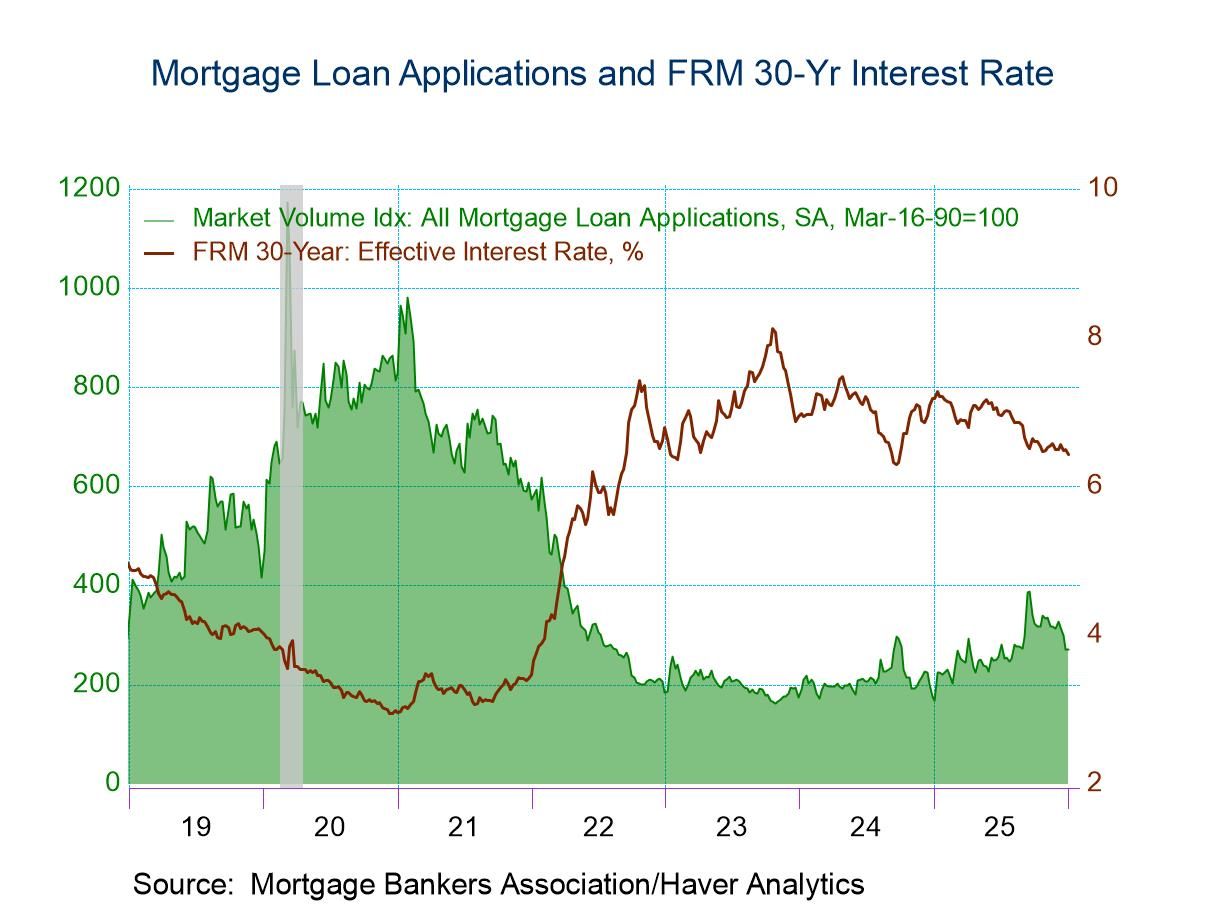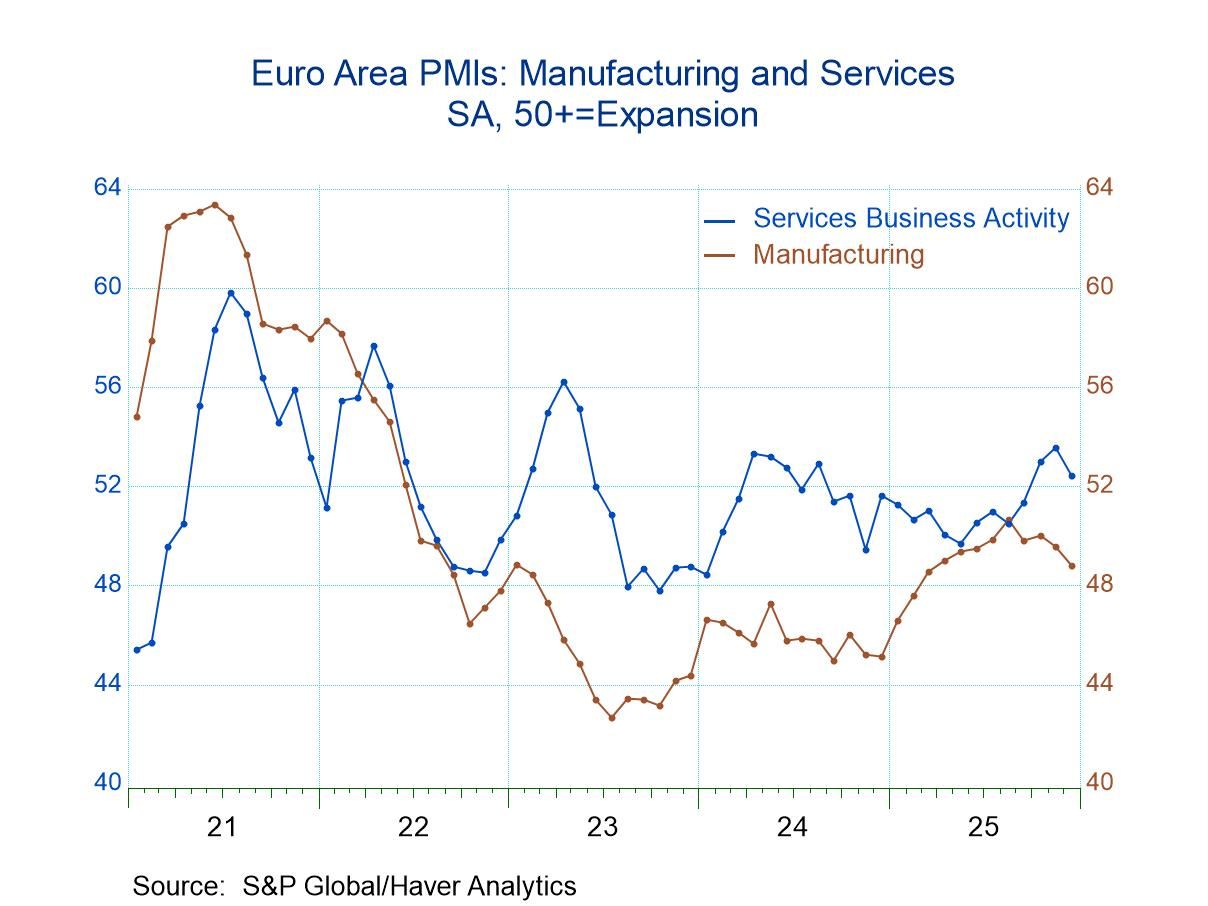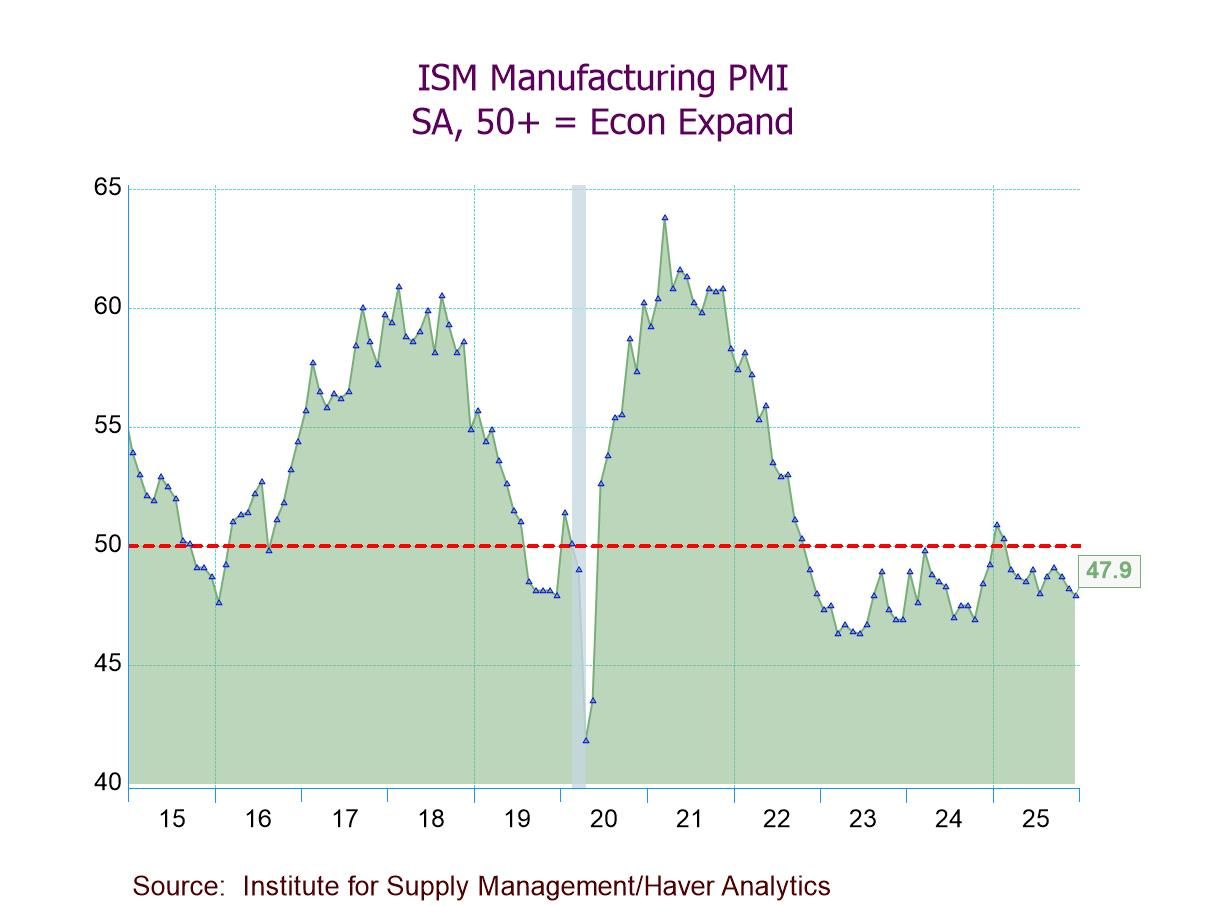 Global| Mar 14 2003
Global| Mar 14 2003Producer Prices Surge, Core Prices Fall
by:Tom Moeller
|in:Economy in Brief
Summary
Finished producer prices surged in February. The jump followed strength the month prior. Consensus expectations were for a 0.6% gain. Finished energy prices surged 7.4% (25.2% y/y), the most for any month since July 1990. Gasoline [...]
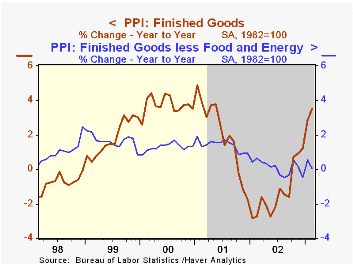
Finished producer prices surged in February. The jump followed strength the month prior. Consensus expectations were for a 0.6% gain.
Finished energy prices surged 7.4% (25.2% y/y), the most for any month since July 1990. Gasoline prices spiked 18.6% (73.9% y/y). Fuel oil prices rose 23.3% (94.0% y/y). Residential gas prices rose 3.2% (19.6% y/y). These energy product price series are NSA.
Finished food prices rose 0.6% (-0.1% y/y) following a 1.6% January jump. Meat prices have been strong.
Excluding food and energy prices were quite a bit weaker than expectations for a 0.1% increase. The 0.5% decline was the third monthly decline in the last four months.
Core finished consumer goods prices fell 0.5% (0.5% y/y) following a strong 0.9% January gain. Price declines were widespread in both durable and nondurable goods categories. Capital goods prices fell 0.4% (-0.4% y/y), the third decline in the last four months.
Intermediate goods prices nearly doubled their huge gain of the prior month and jumped the most for any one month since January 1980. Core intermediate prices also were strong rising the most since April 1995.
Crude goods prices surged for a second month reflecting a 9.3% rise in energy prices. It was the seventh month of strong gain in crude energy prices. Food prices rose a moderate 0.7% (4.1% y/y) following a 5.2% January gain. Core crude prices spiked reflecting more strength in scrap metals prices.
For analysis by the Federal Reserve Bank of St. Louis of the PPI versus the CPI click here.
| Producer Price Index | Feb | Jan | Y/Y | 2002 | 2001 | 2000 |
|---|---|---|---|---|---|---|
| Finished Goods | 1.0% | 1.6% | 3.5% | -1.3% | 2.0% | 3.7% |
| Core | -0.5% | 0.9% | 0.1% | 0.1% | 1.4% | 1.3% |
| Intermediate Goods | 2.1% | 1.3% | 6.7% | -1.5% | 0.4% | 4.9% |
| Core | 0.7% | 0.3% | 2.6% | -0.5% | -0.1% | 2.6% |
| Crude Goods | 4.8% | 6.9% | 36.5% | -10.4% | 0.3% | 22.8% |
| Core | 2.7% | 1.0% | 14.6% | 3.8% | -10.0% | 7.4% |
by Tom Moeller March 14, 2003

Industrial production rose as expected last month following an upwardly revised gain in January. The gains pulled output so far in 1Q 2.0% (AR) above 4Q02. Output fell at a 3.1% last quarter.
Output in the manufacturing sector fell 0.1% (0.9% y/y) following a January gain that was revised up slightly to 0.6%.
Excluding a 2.4% decline in motor vehicle and parts, factory output rose 0.1% (0.4% y/y), the second modest monthly gain following four months of decline. Appliance, furniture & carpeting output rose 0.5% (-1.4% y/y) following a 1.8% decline in January that was much deeper than initially estimated. Computer output fell 0.6% (-6.5% y/y) following a 0.8% January decline that was revised from a small gain.
Output of business equipment was unchanged (-2.3% y/y) following a 0.9% January gain. Output of information processing equipment rose 0.2% (1.2% y/y) following a January gain that was revised up sharply to 2.2%. Output of industrial equipment rose 0.3% (0.1% y/y) for the second month following four months of decline.
Total capacity utilization was unchanged but factory sector utilization reversed half of the prior month's gain and fell to 73.4%.
| Production & Capacity | Feb | Jan | Y/Y | 2002 | 2001 | 2000 |
|---|---|---|---|---|---|---|
| Industrial Production | 0.1% | 0.8% | 1.7% | -0.7% | -3.5% | 4.7% |
| Capacity Utilization | 75.6% | 75.6% | 75.1%(2/02) | 75.6% | 77.3% | 82.7% |
by Tom Moeller March 14, 2003

Total business inventories rose slightly less than expected in January. Nevertheless, the gain continued a moderate rise in inventories that began last May.
Retail inventories rose strongly for the second month led by a 1.9% surge in motor vehicle inventories (18.9% y/y).
Nonauto retail inventories rose just slightly following two months of strong accumulation. Inventories at apparel stores jumped 1.7% (4.2% y/y) for the third monthly surge. Inventories at general merchandise stores fell 0.3% (3.7% y/y) after three months of strong accumulation.
Overall business sales jumped 1.2% (4.2% y/y) led by strength in wholesale and manufacturers' sales.
The inventory-to-sales ratio eased to 1.36, equal to the levels of most of last year.
| Business Inventories | Jan | Dec | Y/Y | 2002 | 2001 | 2000 |
|---|---|---|---|---|---|---|
| Total | 0.2% | 0.7% | 2.2% | 2.0% | -6.4% | 5.6% |
| Retail | 0.7% | 0.7% | 7.7% | 7.8% | -5.0% | 6.1% |
| Retail excl. Autos | 0.1% | 0.8% | 3.0% | 3.1% | -2.1% | 4.1% |
| Wholesale | -0.2% | 0.8% | 0.1% | -0.1% | -5.7% | 6.6% |
| Manufacturing | -0.0% | 0.6% | -1.3% | -1.9% | -8.0% | 4.5% |
by Tom Moeller March 14, 2003

The Mid-March reading of Consumer Sentiment from the University of Michigan fell more than expected versus February. The 6.1% m/m decline to 75.0 was versus Consensus expectations for a reading of 78.0.
The index of current conditions and expectations both fell sharply.
Over the last 10 years there has been a 63% correlation between the level of consumer sentiment and the y/y change in real PCE. That correlation rose to 81% during the last five years.
The University of Michigan survey is not seasonally adjusted.It is based on telephone interviews with 250 households nationwide on personal finances and business and buying conditions. The survey is expanded to a total of 500 interviews at month end.
| University of Michigan | Mid-March | Feb | Y/Y | 2002 | 2001 | 2000 |
|---|---|---|---|---|---|---|
| Consumer Sentiment | 75.0 | 79.9 | -21.6% | 89.6 | 89.2 | 107.6 |
by Tom Moeller March 14, 2002
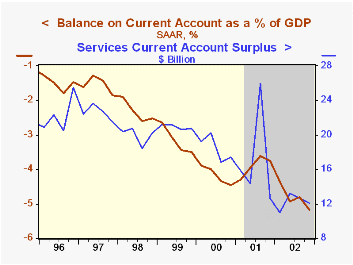
The US current account deficit deepened about as expected last quarter, but set a new record. The deficit in 3Q was revised slightly shallower.
The deficit in goods trade deteriorated to $529.0B (AR) in 4Q02 versus a $484.4B deficit for all of last year and $427.2B in 2001. Exports of merchandise fell 5.0% last year following a 6.9% drop in 2001. Goods imports rose 1.8% vs. a 6.4% decline the year prior.
Services managed a $48.2B (AR) surplus last quarter and a $48.8B surplus for the year. That, however, was down from a peak services surplus of $90.4B in 1997. The US surplus in travel shrank to $11.0B last year from $21.4B in 1997. The balance on defense expenditures turned to a $7.4B deficit versus a $5.0B surplus in 1997.
| US Int'l Balance of Payments | 4Q '02 | 3Q '02 | Y/Y | 2002 | 2001 | 2000 |
|---|---|---|---|---|---|---|
| Current Account Deficit | $136.9B | $126.3B | $95.1B | $503.4B | $393.4B | $410.3B |
| % of GDP | 5.2% | 4.8% | 3.8% | 4.8% | 3.9% | 4.2% |
| Deficit on Gds, Serv. & Income | $122.8B | $113.3B | $81.5B | $447.4B | $343.9B | $356.9B |
| Exports | -1.3% | 2.4% | 5.7% | -5.1% | -9.6% | 13.6% |
| Imports | 1.2% | 1.4% | 15.5% | 2.4% | -8.4% | 18.9% |
| Unilateral Transfers Deficit | $14.1B | $13.1B | $13.6B | $56.0B | $49.5B | $53.4B |
Tom Moeller
AuthorMore in Author Profile »Prior to joining Haver Analytics in 2000, Mr. Moeller worked as the Economist at Chancellor Capital Management from 1985 to 1999. There, he developed comprehensive economic forecasts and interpreted economic data for equity and fixed income portfolio managers. Also at Chancellor, Mr. Moeller worked as an equity analyst and was responsible for researching and rating companies in the economically sensitive automobile and housing industries for investment in Chancellor’s equity portfolio. Prior to joining Chancellor, Mr. Moeller was an Economist at Citibank from 1979 to 1984. He also analyzed pricing behavior in the metals industry for the Council on Wage and Price Stability in Washington, D.C. In 1999, Mr. Moeller received the award for most accurate forecast from the Forecasters' Club of New York. From 1990 to 1992 he was President of the New York Association for Business Economists. Mr. Moeller earned an M.B.A. in Finance from Fordham University, where he graduated in 1987. He holds a Bachelor of Arts in Economics from George Washington University.



